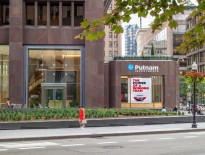
Patrick McMahon
In the last decade, we have witnessed a transformation of the traditional office environment, the stereotypical employee and the nine-to-five work day. Companies are no longer seeking parking lots to accommodate all of their employees, top floors with multiple corner offices or on-site cafeterias. Attracting and retaining talent in 2018 requires a mix of innovation, flexibility, community and vibrancy – a challenging combination of demands that companies and commercial office buildings are struggling to answer.
Boston is one of the country’s most competitive markets for talent; unemployment here is a full percentage point below the national average. While today’s office amenities – free food, roof decks, pool tables and pet-friendly policies – are enticing, they only begin to scratch the surface. Attracting today’s knowledge worker means offering an integrated environment that features access to rapid transit, multiple high-quality dining choices, fitness studios for a quick workout, entertainment options, open space and access to retail stores for crossing off those weekend errands.
At Assembly Row, office leasing took off once restaurants and bars began opening alongside appealing retail and residences. The addition of a 6-acre riverfront park and a new MBTA Station to this new, amenity-rich neighborhood helped create a vibrant office market. Today, Assembly Row’s retail-lined streets are activated by more than 4,800 office workers who are largely interchangeable with shoppers, hotel guests and over 1,500 residents. And in more than a handful of cases, the resident, the office worker and the shopper are the same person.
A One-Stop-Shop for Workers
Existing properties – from downtown to suburban Boston – are being renovated and transformed into more dynamic environments, creating that power of place. One example is The District Burlington, where National Development reimagined a sterile former office park into a dynamic community of premiere workspace, residences, restaurants and a hotel all incorporated into a town-center environment.
Municipalities are requiring new developments include different real estate asset classes as well as public spaces. In Kendall Square, one of the tightest office markets in the country, the city of Cambridge has required developers to incorporate housing and open space into their commercial development plans – ensuring city residents and graduate students are accommodated alongside office workers.
To create the power of place in Boston’s downtown office buildings, developers and architects are working together to understand how to add amenities like a fitness center, outdoor space, breakout rooms and conference capabilities when renovating or repositioning existing properties. Not coincidentally, these features match the amenities people are finding in their new residential buildings.
Even parking garages are poised to enjoy a rebirth. With more people taking alternative modes of transportation to work – and the promise of driverless cars – the demand for parking is slipping. Developers are thinking about the best ways to convert garages to office or residential use in the future.
Great environments lead to a better quality of life. All developers should ask themselves, “If I worked here, what quality of life would I have?” And then make it better.
Patrick McMahon is vice president of development at Federal Realty Investment Trust.




 |
| 
